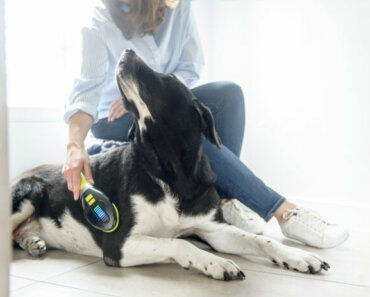Whether it’s your first time or the tenth, seeing your dog experience a seizure is always scary. It’s heartbreaking to see our furry friends’ bodies and brains struggle through a seizure event, and it can leave us living under a cloud of concern, waiting for the next storm to break. To make it less scary and, more importantly, give your beloved pooch’s body a break from the stress of regular occurrences, it helps to understand seizures in dogs – and learn what we can do to help.
Let’s start with the good news:
- As scary, and dramatic, as they are to witness, you can rest assured that your dog is not in pain when a seizure strikes. Indeed, quite often dogs don’t even realize they’ve had a seizure once it’s over.
- There are some simple ways to regain some control over your dog’s seizures, and your own peace of mind. Starting with an understanding about:
a. what is happening,
b. why it’s happening, and
c. how to help. (Spoiler alert: this step includes asking your vet about KBroVet®️-CA1, a game changer in controlling seizures associated with idiopathic epilepsy in dogs. Keep reading for the inside scoop!)
What are Seizures in Dogs?
Your first step to understanding what your dog is going through, is knowing what a seizure is: a sudden and uncontrolled burst of electrical activity in the brain. In dogs, this may manifest as various physical and behavioral symptoms, such as:
- Convulsions
- Collapse
- Drooling
- Unusual movements – such as stiffening or paddling of the limbs
- Jaw chomping
- Occasional loss of urine or feces
- Or even loss of consciousness
From here, it’s important to figure out what might be causing the seizures.
What Causes Seizures in Dogs?
As reported by the Ohio State University Veterinary Medical Center, canine epilepsy, or idiopathic epilepsy (IE) – recurrent seizures with no identifiable cause – is believed to be the most common cause of seizures in dogs between one and five years of age.
If your dog is among these, it is important to talk to your vet to figure out if your dog is indeed an IE patient, or if their seizures are caused by something else, allowing you to adopt the correct treatment plan.
Other possible causes of seizures in dogs include things like:
a. Excess or deficit of glucose, electrolytes, triglycerides, etc.
b. Metabolic disease caused by kidney or liver disorders
c. Ingesting toxins or poisons such as chocolate, specific plants, human medication, etc.
d. Tumor or other progressive brain disease
e. Scarring of brain tissue after surgery or some sort of head trauma
f. Infectious diseases such as encephalitis, canine distemper virus or rabies
Triggers for IE Seizure Activity
Once you have ruled out all the above, and armed with an IE diagnosis, you can then learn to spot, and stop, triggers for epileptic seizure activity. Triggers to watch out for may include:
- Stress or anxiety
- Changes in life situation or routine
- Unfamiliar places or faces (visitors in the home, for example)
- Hot weather
- Extreme excitement
- Hormonal factors
- Sleep deprivation
Seizure Solutions
Now for the really good part: knowing how to help!
In the moment, you can prevent your dog from hurting himself with some simple solutions:
- keep him away from stairs,
- cushion his head,
- gently hold and comfort him until he begins to regain consciousness.
More importantly, though, you are going to want to get some professional help controlling the frequency and intensity of your pooch’s attacks in the long-term. This is where KBroVet®️-CA1 comes into play.
A once-daily tablet, in the form of a tasty treat, KBroVet®️-CA1 is formulated to add a consistent and reliable source of potassium bromide to your dog’s system:
- Potassium bromide causes a drop in chloride levels in the brain.
- This, in turn, stops the central nervous system from being too active.
- All of which makes it harder for seizures to start.
The first drug conditionally approved by the FDA for the control of seizures associated with idiopathic epilepsy in dogs, speak to your vet to find out if KBroVet®️-CA1 might be right for your dog.
Understanding exactly what you’re dealing with is essential for your seizure-beleaguered pooch’s well-being. While epilepsy can be challenging to manage, this knowledge, along with a little bit of help from innovators like PRN Pharmacal and KBroVet®️-CA1, is a surefire way to seize back some control!
*Important Safety Information
KBroVet®-CA1 is conditionally approved by FDA pending a full demonstration of effectiveness under application number 141-544. See prescribing information for complete details regarding adverse events, warnings, and precautions. It is a violation of Federal Law to use this product other than as directed in the labeling. Contraindicated in dogs with a history of hypersensitivity to bromide. Not for use in cats. Not for human use. Keep out of reach of children. Contact a physician in case of accidental ingestion by humans. The most commonly reported side effects were increased appetite and thirst, increased urination, weight gain, sedation, and ataxia. Reversible neurologic signs (sedation, ataxia, weakness) were generally associated with adjunctive potassium bromide treatment or high serum bromide concentrations. Animals with kidney disease may be predisposed to bromide toxicities. The safe use of KBroVet-CA1 has not been evaluated in dogs that are intended for breeding, are pregnant or lactating, or less than 6 months of age. Use caution when changing diets, administering chloride-containing IV fluids, and administering concurrent medications. Careful monitoring is important in dogs that have a condition that may cause difficulty maintaining electrolyte balance.
Animal Wellness is North America’s top natural health and lifestyle magazine for dogs and cats, with a readership of over one million every year. AW features articles by some of the most renowned experts in the pet industry, with topics ranging from diet and health related issues, to articles on training, fitness and emotional well being.




























